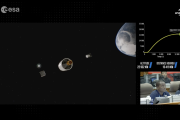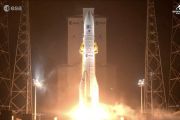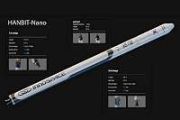
Copernical Team
ISRO's LVM3 launches 36 OneWeb satellites in sixth consecutive flight
 The Indian Space Research Organisation (ISRO) successfully launched 36 satellites belonging to OneWeb Group Company into their intended 450 km circular orbit with an inclination of 87.4 degrees, using its LVM3 launch vehicle. This marked the sixth consecutive successful flight of the LVM3 and the successful execution of NSIL's contract to launch 72 OneWeb satellites to Low Earth Orbit.
The
The Indian Space Research Organisation (ISRO) successfully launched 36 satellites belonging to OneWeb Group Company into their intended 450 km circular orbit with an inclination of 87.4 degrees, using its LVM3 launch vehicle. This marked the sixth consecutive successful flight of the LVM3 and the successful execution of NSIL's contract to launch 72 OneWeb satellites to Low Earth Orbit.
The Exolaunch slots in over 15 customer satellites onto Spacex Transporter-7 from Vandenberg
 For its seventh dedicated rideshare mission with SpaceX, Exolaunch, a global leader in small satellite launch services, mission management and deployment systems, performed the integration of over 15 satellites for customers around the globe. The SpaceX Transporter-7 mission is scheduled for launch to a Sun-Synchronous Orbit (SSO) above 500 km from Vandenberg Space Force Base in California no ea
For its seventh dedicated rideshare mission with SpaceX, Exolaunch, a global leader in small satellite launch services, mission management and deployment systems, performed the integration of over 15 satellites for customers around the globe. The SpaceX Transporter-7 mission is scheduled for launch to a Sun-Synchronous Orbit (SSO) above 500 km from Vandenberg Space Force Base in California no ea Small stars may host bigger planets than previously thought
 Stars with less than half the mass of our Sun are able to host giant Jupiter-style planets, in conflict with the most widely accepted theory of how such planets form, according to a new study led by UCL and University of Warwick researchers.
Gas giants, like other planets, form from disks of material surrounding young stars. According to core accretion theory, they first form a core of roc
Stars with less than half the mass of our Sun are able to host giant Jupiter-style planets, in conflict with the most widely accepted theory of how such planets form, according to a new study led by UCL and University of Warwick researchers.
Gas giants, like other planets, form from disks of material surrounding young stars. According to core accretion theory, they first form a core of roc AI finds that first stars were clustered together
 An international team has used artificial intelligence to analyze the chemical abundances of old stars and found indications that the very first stars in the Universe were born in groups rather than as isolated single stars. Now the team hopes to apply this method to new data from on-going and planned observation surveys to better understand the early days of the Universe.
After the Big Ba
An international team has used artificial intelligence to analyze the chemical abundances of old stars and found indications that the very first stars in the Universe were born in groups rather than as isolated single stars. Now the team hopes to apply this method to new data from on-going and planned observation surveys to better understand the early days of the Universe.
After the Big Ba New study about the 'tsunami' in Venus's clouds
 A group of scientists from the University of Seville, in collaboration with experts from the University of the Basque Country, has led the first detailed study of the evolution of the discontinuity of Venus's clouds, a gigantic atmosphere wave with the appearance of a "tsunami" that is propagated in the planet's deepest clouds and which, it is believed, may be playing a very significant role in
A group of scientists from the University of Seville, in collaboration with experts from the University of the Basque Country, has led the first detailed study of the evolution of the discontinuity of Venus's clouds, a gigantic atmosphere wave with the appearance of a "tsunami" that is propagated in the planet's deepest clouds and which, it is believed, may be playing a very significant role in An explaination for unusual radar signatures in the outer solar system
 A study co-authored by Southwest Research Institute Senior Research Scientist Dr. Jason Hofgartner explains the unusual radar signatures of icy satellites orbiting Jupiter and Saturn. Their radar signatures, which differ significantly from those of rocky worlds and most ice on Earth, have long been a vexing question for the scientific community.
"Six different models have been published in
A study co-authored by Southwest Research Institute Senior Research Scientist Dr. Jason Hofgartner explains the unusual radar signatures of icy satellites orbiting Jupiter and Saturn. Their radar signatures, which differ significantly from those of rocky worlds and most ice on Earth, have long been a vexing question for the scientific community.
"Six different models have been published in Hubble monitors changing weather and seasons at Jupiter and Uranus
 Ever since its launch in 1990, NASA's Hubble Space Telescope has been an interplanetary weather observer, keeping an eye on the largely gaseous outer planets and their ever-changing atmospheres. NASA spacecraft missions to the outer planets have given us a close-up look at these atmospheres, but Hubble's sharpness and sensitivity keeps an unblinking eye on a kaleidoscope of complex activities ov
Ever since its launch in 1990, NASA's Hubble Space Telescope has been an interplanetary weather observer, keeping an eye on the largely gaseous outer planets and their ever-changing atmospheres. NASA spacecraft missions to the outer planets have given us a close-up look at these atmospheres, but Hubble's sharpness and sensitivity keeps an unblinking eye on a kaleidoscope of complex activities ov UTEP joins project to 3D print batteries from lunar and Martian soil
 The University of Texas at El Paso has joined a project led by NASA to leverage 3D-printing processes with the aim of manufacturing rechargeable batteries using lunar and Martian regolith, which is the top layer of materials that covers the surface of the moon and Mars.
"UTEP is a national leader in additive manufacturing for space applications," said Kenith Meissner, Ph.D., dean of the UT
The University of Texas at El Paso has joined a project led by NASA to leverage 3D-printing processes with the aim of manufacturing rechargeable batteries using lunar and Martian regolith, which is the top layer of materials that covers the surface of the moon and Mars.
"UTEP is a national leader in additive manufacturing for space applications," said Kenith Meissner, Ph.D., dean of the UT SpaceX launches 56 Starlink satellites from Florida
 SpaceX launched 56 Starlink satellites from Florida's Cape Canaveral Space Force Station Friday.
The satellites were carried into low-Earth orbit aboard a Falcon 9 rocket which lifted off at 11:43 a.m. EDT.
The reusable first stage booster separated shortly after liftoff and returned to Earth where it landed on the "Shortfall of Gravitas" drone ship in the Atlantic Ocean approxim
SpaceX launched 56 Starlink satellites from Florida's Cape Canaveral Space Force Station Friday.
The satellites were carried into low-Earth orbit aboard a Falcon 9 rocket which lifted off at 11:43 a.m. EDT.
The reusable first stage booster separated shortly after liftoff and returned to Earth where it landed on the "Shortfall of Gravitas" drone ship in the Atlantic Ocean approxim The race is on for Ingenuity and Perseverance to stay the distance
 The Perseverance rover spent the first two Earth years of its mission on Mars driving and sampling within Jezero crater. As anticipated, Jezero was found to be rich with interesting geological features, and the rover used 21 of its precious 43 sample tubes in the region. The rover wrapped up this science campaign by dropping 10 of these samples in a backup depot area for retrieval by a future mi
The Perseverance rover spent the first two Earth years of its mission on Mars driving and sampling within Jezero crater. As anticipated, Jezero was found to be rich with interesting geological features, and the rover used 21 of its precious 43 sample tubes in the region. The rover wrapped up this science campaign by dropping 10 of these samples in a backup depot area for retrieval by a future mi 



























